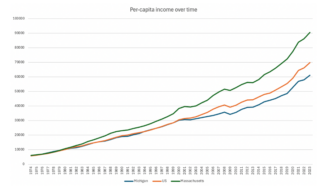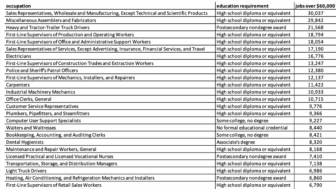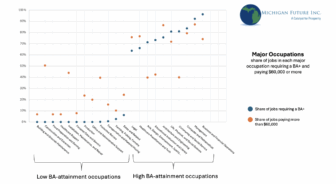
Michigan’s core economic challenge is there are too many low-wage jobs. It is the primary reason for the Michigan Association of United Ways finding that a way too high 43 percent of Michigan households in a strong economy cannot pay for basic necessities.
The reality of too many low-pay jobs is true across the state––nationally too. It gets worse the smaller the region. Nationally 51 percent of jobs are in occupations that pay less than the national median of $38,640. In Michigan it is 58 percent.
To put the national median in context, The Michigan Association of United Ways calculates the cost of paying for basic necessities in Michigan is $61,272 for a family of four (two adults with one infant and one preschooler).
Only two Michigan regions have the portion of jobs in occupations that pay less than the national median below the nation’s. Ann Arbor (46 percent) and Detroit (47 percent). Lansing (52 percent) is the only other region below 60 percent of jobs that are in occupations that pay less than the national median.
The remaining Michigan regions range from 62 percent (Grand Rapids) to 79 percent (Northeast Lower Peninsula). The details:
- between 60 and 65 percent: Grand Rapids, Kalamazoo, Midland, Saginaw
- between 65 and 70 percent: Flint, South Bend (which includes Cass County), Jackson, Battle Creek, Northwest Lower Peninsula, Upper Peninsula, Muskegon
- between 70 and 75 percent: Monroe, nonmetropolitan counties in southern Michigan, Niles-Benton Harbor
- between 75 and 80 percent: Bay City, Northeast Lower Peninsula
Egads! The predominance of jobs that pay below the nation median is way too high everywhere in Michigan. But is astonishingly high in the state’s small- and mid-sized regions and even more so in rural areas. And Michigan’s second biggest metro, Grand Rapids, has a very high rate of jobs in occupations that pay less than the national median for a metro with a population of one million or more.
The concentration of low-wage jobs in smaller regions is consistent with the nation. A recent New York Times article by Eduardo Porter entitled Why Midsize Cities Struggle to Catch Up to Superstar Cities lays out the reasons this is occurring. Mainly that high-paid jobs are now concentrated in what we call knowledge-based services (heath care, education, professional and business services, information, and finance and insurance) and knowledge-based services are concentrating in regions with high proportions of adults with a four-year degree or more.
This is the same story as what is happening in Texas that we explored in a recent post. Where nearly all the job growth, particularly the good-paying job growth, is concentrating in the state’s four big regions.
For those of you wanting to learn more about the geographic distribution of better-paid work check out this presentation by MIT economist David Autor. Autor details the decline of middle-skill jobs; the rise of high-skill jobs and their concentration in big metros; and that low-skill jobs, no matter where they are located, are low-wage jobs. Which explains why the low-paid jobs proportions are so high in big metros as well as small population regions.
These realities––way too many low-wage jobs and the difficulty of small population regions to retain and attract high-wage employers––are structural challenges that are not going to fixed by a growing economy. That is why Michigan Future, in our state economic policy agenda, has made our first and foremost recommendation adopting rising household income for all Michiganders as the state’s economic mission. We write:
We are committed to the goal of recreating a high prosperity Michigan. We believe the goal of state economic policy should be raising household income for all Michiganders. High prosperity is different from the most often-used measure for economic success, low unemployment. It is being a place with a broad middle class where wages and benefits allows one to pay the bills, save for retirement and the kids’ education and pass on a better opportunity to the next generation.
… We agree with President Reagan when he said a job is the best social program. To us a good-paying job is the best social program.







